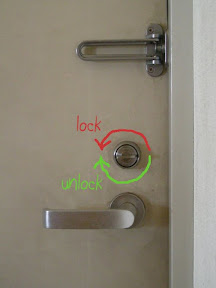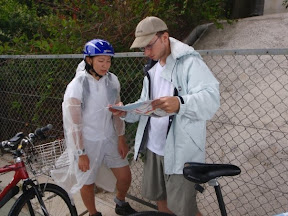|
I assume 90% of you won’t be interested in it, but I’ve added a little widget to the lower right of my blog layout that shows my current jubeat game data. If you want, you can fiddle with it and see how I’ve done on any of the game’s ~60 songs and three difficulty levels, as well as my current class and national rank (currently S2 and 5448th, respectively). That is all. Have fun fiddling. 😉 |
Author: David
-
My jubeat game data
-
Just when you think you’ve got it down
I just had a humbling experience at the bank.
As you may or may not know, I’m a rather independent person. Much to my mother’s chagrin, I used to take lots of things apart when I was young, just so I could see how they worked and put them back together. I like not having to rely on other people’s help to fix things, or get stuff done, you know?
In fact, part of my motivation for coming to Japan was that it would force me out of my comfort zone- because I knew I wouldn’t understand Japanese life, I knew I would be “off balance” and have to figure many things out anew. When I first arrived, I quickly discovered that you can’t have pride if you don’t understand your surroundings; you need to be willing to ask for help and rely on the kindness of strangers.
After living here for almost a year and a half though, you get into the routine of daily life, and it’s easy to forget the helplessness that was at first a daily experience.
Anyway, I recently completed the registration process for a GoLloyd’s account. It’s commonly recognized as the cheapest way to send money home, but I’d put off the signup process for a long time because it involves mailing copies of your passport and alien registration card to their headquarters in Tokyo with your application form. With the welcome packet, I received general instructions on how to transfer money using GoLloyd’s, and some pertinent terms in Japanese. Armed with their instructions and list of kanji, I went to my local bank to use an ATM to send some money, and quickly realized I was in over my head.
Japanese ATMs are wondrous pieces of machinery (one of which is pictured above), allowing you to complete all manner of transactions, including the inter-bank transfer I needed to do. Unfortunately, only a few ATMs have English menus, and only for basic functions. I fuddled my way around the menu system for a few minutes and got about halfway through the process while a bank employee stood about eight feet behind me, waiting to see if I needed help. I eventually gave up and tried to ask her, but ended up at a teller window after a brief wait in line. The teller then walked me back to the lobby attendant and asked her to help me do the transfer using the ATM. All semblance of self-reliance now gone, she read in Japanese from the help page GoLloyd’s sent (thank goodness they included Japanese instructions- written specifically to Japanese bank staff to help confused gaijin) and walked me through the process. I tried to follow along, but there were too many menus in kanji I didn’t understand, and knew I wouldn’t be able to repeat the process.
I’d heard that getting a separate ATM card specifically for transfers simplifies the process, so after the transfer was done, I asked her about getting one (so I could hopefully be self-reliant in the future). She kindly walked me back to the ATM and showed me that my ATM card stored the transfer settings for future use, making it even simpler than having a separate card for transfers. I thanked her profusely and left the bank.
-
It’s the Little Things #2
In Japan, patrons get a little plastic basket to hold movie concession items. At the end of the movie, employees stand outside each auditorium to collect the baskets (now containing each patron’s refuse).
Also possibly related- Japanese theater floors are not sticky.
Basket pictured in front of a Terminator 4 (ターミãƒãƒ¼ã‚¿ãƒ¼4) poster
-
It’s the Little Things #1
I’m starting a new series of posts on my blog today. It’s basically just a quick blurb about something unexpectedly different between America and Japan. So, without further ado, here’s “It’s the Little Things,” part the first.
 99% of the time (anecdotally, of course) locks in Japan lock with what I’d call “underhand” rotation, meaning that the lower part of the lock matches the movement of the bolt- as opposed to American locks, where the movement of the bolt typically mirrors the movement of the upper part of the lock.
99% of the time (anecdotally, of course) locks in Japan lock with what I’d call “underhand” rotation, meaning that the lower part of the lock matches the movement of the bolt- as opposed to American locks, where the movement of the bolt typically mirrors the movement of the upper part of the lock.Pictured is my apartment door, currently locked.
-
I’m going to be an English teacher
I had a kid visit class today that really scared me. Not in a “trenchcoat mafia” kind of way, but in a “holy crap, your existence shakes the core of what I know about how to do my job” kind of way.
For the first time since I moved to Japan, I met a bilingual Japanese kid.
He’s six years old, and his English speaking ability is arguably better than my office manager’s (listening unarguably so). He goes to a special school that’s taught all in English, a school which Ms. Semba says “only very rich families can pay for.” He and his classmates are only allowed to speak English while at school, so speaking English is (literally) second nature to him. Neither of his parents speak it fluently, though his mom chopped together a “thank you” when I complimented her son’s language skills, so it’s apparently all learned at school. He says his class is very small, and that makes sense from a practical perspective; if you need to police young’uns’ predilections to speak the same language at school as they do at home, it’s far easier to do if you can count them on your fingers. I’m seriously impressed at the level of dedication his parents have to teaching him speak English well.
But here’s the thing- if he’s going to be one of my students, what the heck am I going to do with him? The difficulty levels of the books I currently use progress in maturity and English ability in accordance with the average ESL learner, which means that the books I have at his English level are aimed at young adults. While he was in the office today, he spent some time in my classroom with three other kids his age who all barely know the alphabet. I talked to him like I would any American child, and he seemed to have the vocabulary of the average American first grader, which brings me back to my point.
I’m scared of having him as a student because it means I’ll have to do some serious growing as a teacher. I’ve become comfortable with my role as an ESL teacher, and now I’m going to have to be a “regular” English teacher to two kids (he’s bringing a friend from school) who already speak English.
I guess this means I’m going to be expanding my repertoire, which is good. It’ll involve more work than I’m doing right now, because I can’t imagine Ms. Semba will spring for any more books, especially for an unusual situation like this. That means I’m going to have to come up with a new curriculum, but I’m not sure where to start. American Language School is an “eikaiwa,” literally “English conversation” school, and the point of all our lessons is English communication, but I can’t just sit and have a chat with a couple of six-year olds.
I think I have a lot of reading to do. If you’re a teacher with experience teaching language skills to children, do you have any specific suggestions where I should start?
-
Hanami
It’s spring in Japan, and that means enjoying the cherry blossoms (花見 – hanami). You’ve probably heard the Japanese word for cherry blossoms before; it’s Sakura (æ¡œ), and it’s also used as a girl’s name here. These trees are all over the country, and the small flowers that cover the trees make them look like little clouds on dark knurled columns.
Without the flowers, the trees aren’t very attractive. They have sort of a dark mottled bark, and when the flowers bloom, the contrast is surprising, to say the least. There’s a lot of variance in flower color, too- everything from deep red to pure white, though light pink seems to be the most common here in Matsuyama.
On Sunday, I went to Dogo Park, and it was an absolute madhouse. I think it was a national holiday weekend of some sort, and half of Matsuyama’s residents were in the park. Every reasonably flat surface was covered with blue tarps and roll-up mats where people were enjoying the beautiful day. There was a general festival atmosphere, with booths set up along the main footpaths selling everything from cheap plastic toys to cooked food to “fresh” charcoal.
People were playing games in open spaces, and it was really neat to see all the families and friends just out having a good time. It’s days like this that make me appreciate the Japanese sense of family. However, it’s also days like this that make me wonder if maybe some people might be happier if they weren’t in the thick of the throngs all doing the same things at the same time, if they considered breaking from the pack.
As I mentioned, hanami is a popular pastime, and people often bring their whole family or group of friends to the park to grill meat over small barbecues. The first picture shows some of my friends out at Dogo Park enjoying the day. The rest are from trips to Matsuyama Castle and Matsuyama “General” Park.




